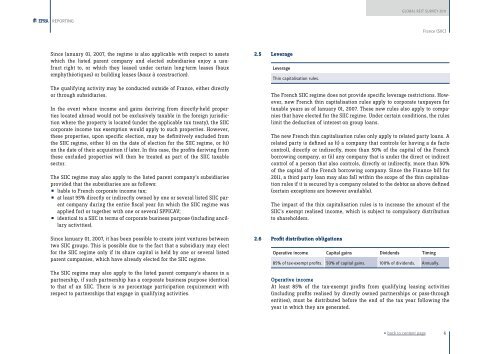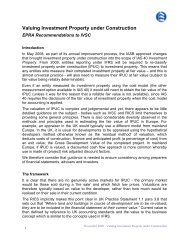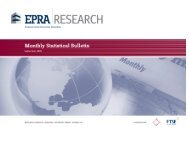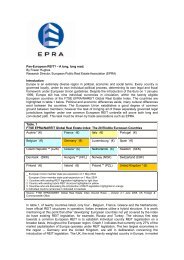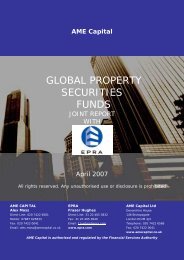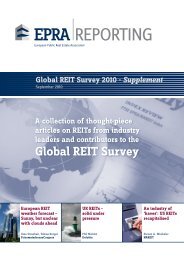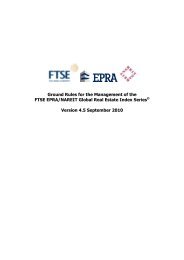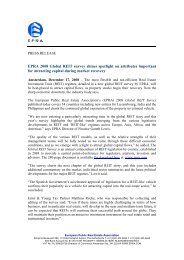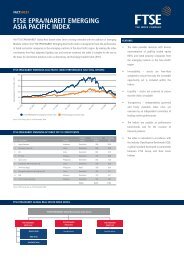Global REIT Survey 2011 - EPRA
Global REIT Survey 2011 - EPRA
Global REIT Survey 2011 - EPRA
You also want an ePaper? Increase the reach of your titles
YUMPU automatically turns print PDFs into web optimized ePapers that Google loves.
<strong>Global</strong> <strong>REIT</strong> <strong>Survey</strong> <strong>2011</strong>REPORTINGFrance (SIIC)Since January 01, 2007, the regime is also applicable with respect to assetswhich the listed parent company and elected subsidiaries enjoy a usufructright to, or which they leased under certain long-term leases (bauxemphythéotiques) or building leases (baux à construction).The qualifying activity may be conducted outside of France, either directlyor through subsidiaries.In the event where income and gains deriving from directly-held propertieslocated abroad would not be exclusively taxable in the foreign jurisdictionwhere the property is located (under the applicable tax treaty), the SIICcorporate income tax exemption would apply to such properties. However,these properties, upon specific election, may be definitively excluded fromthe SIIC regime, either (i) on the date of election for the SIIC regime, or (ii)on the date of their acquisition if later. In this case, the profits deriving fromthese excluded properties will then be treated as part of the SIIC taxablesector.The SIIC regime may also apply to the listed parent company’s subsidiariesprovided that the subsidiaries are as follows:liable to French corporate income tax;• at least 95% directly or indirectly owned by one or several listed SIIC par-• ent company during the entire fiscal year (in which the SIIC regime wasapplied for) or together with one or several SPPICAV;identical to a SIIC in terms of corporate business purpose (including ancil-• lary activities).Since January 01, 2007, it has been possible to create joint ventures betweentwo SIIC groups. This is possible due to the fact that a subsidiary may electfor the SIIC regime only if its share capital is held by one or several listedparent companies, which have already elected for the SIIC regime.The SIIC regime may also apply to the listed parent company’s shares in apartnership, if such partnership has a corporate business purpose identicalto that of an SIIC. There is no percentage participation requirement withrespect to partnerships that engage in qualifying activities.2.5 LeverageLeverageThin capitalisation rules.The French SIIC regime does not provide specific leverage restrictions. However,new French thin capitalisation rules apply to corporate taxpayers fortaxable years as of January 01, 2007. These new rules also apply to companiesthat have elected for the SIIC regime. Under certain conditions, the ruleslimit the deduction of interest on group loans.The new French thin capitalisation rules only apply to related party loans. Arelated party is defined as (i) a company that controls (or having a de factocontrol), directly or indirectly, more than 50% of the capital of the Frenchborrowing company, or (ii) any company that is under the direct or indirectcontrol of a person that also controls, directly or indirectly, more than 50%of the capital of the French borrowing company. Since the Finance bill for<strong>2011</strong>, a third party loan may also fall within the scope of the thin capitalizationrules if it is secured by a company related to the debtor as above defined(certain exceptions are however available).The impact of the thin capitalisation rules is to increase the amount of theSIIC’s exempt realised income, which is subject to compulsory distributionto shareholders.2.6 Profit distribution obligationsOperative income Capital gains Dividends Timing85% of tax-exempt profits. 50% of capital gains. 100% of dividends. Annually.Operative incomeAt least 85% of the tax-exempt profits from qualifying leasing activities(including profits realised by directly owned partnerships or pass-throughentities), must be distributed before the end of the tax year following theyear in which they are generated.« back to content page6


